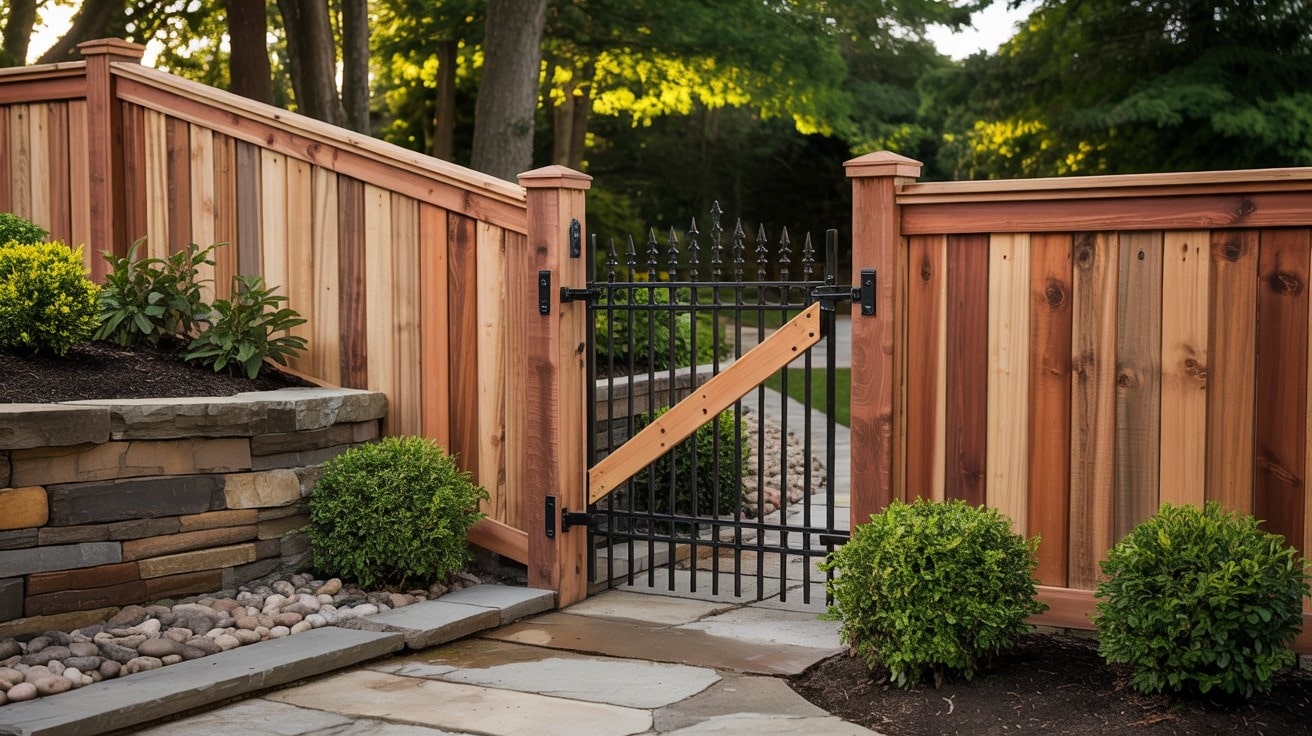Do you want to add a fence to your retaining wall but feel stuck? I get it. Your standard fence methods just won’t work here – those basic post-digging techniques fall short when dealing with a solid wall structure.
Building a fence on a retaining wall needs special methods to make sure it stays put and lasts for years. The good news is that with the right steps, you can do this job yourself and save money while getting great results.
In this blog, I’ll show you the exact steps to build a sturdy fence on your retaining wall, from picking the right materials to the final touches.
In this, you’ll learn how to handle the unique challenges of working with retaining walls and create a fence that looks good and works well.
Understanding Retaining Walls and Fence Compatibility
Retaining walls hold back soil and create level areas in sloped yards. They face constant pressure from the earth they hold back, which affects how you can attach fences to them.
The wall’s material – concrete, block, stone, or timber – determines your attachment method. Before adding a fence, you need to check whether your wall is leaning, cracking, or showing other signs of weakness that might make it unsafe for a fence addition.
Important Fence Considerations
- Must not compromise wall stability or function
- Should withstand local wind conditions
- Needs proper anchoring systems based on the wall type
- May require special hardware like sleeve anchors or brackets
- Must follow local building codes for height and placement
- Should include adequate drainage considerations
- Requires appropriate spacing between posts based on wall strength
Planning Your Fence Project
Good planning makes fence building on a retaining wall much easier. You need to take time to think through all the steps before buying any materials or tools. This saves you money and prevents mistakes that could damage your wall or lead to a weak fence.
First, measure the length, height, and width of your retaining wall. Taking photos helps when shopping for materials. Note any curves, corners, or changes in height along the wall. These spots need special attention during installation.
The fence style matters a lot for this project. Some designs work better than others on retaining walls. Wood, vinyl, metal, or composite materials each have pros and cons. Pick a material that fits your budget and matches your home’s look. Some materials, like wood, need more care over time.
Check the condition of the wall one more time. If you see any cracks, leaning, or bulging, fix these issues before adding a fence. The wall must be strong enough to hold the extra weight and wind pressure of a fence.
Key Planning Steps
- Measure wall dimensions (length, height, thickness)
- Choose fence material based on durability and maintenance needs
- Make detailed drawings with post locations marked
- Create a timeline with buffer days for weather delays
- Check for underground utilities before any digging
- Gather all tools before starting the project
Fence on Retaining Wall: Step-By-Step Installation Process
Installing a fence on your retaining wall takes patience and careful work. Follow these steps to build a strong fence that will last for years.
Tools and Materials Needed
Before you start your fence project on a retaining wall, make sure you have all the necessary tools and materials ready. This will help your project go smoothly without frustrating trips to the hardware store mid-installation.
| Category | Items |
|---|---|
| Basic Tools | Tape measure, level, chalk line, pencil/marker, hammer, drill with masonry bits, wrench set, saw, post level. |
| Power Tools | Hammer drill, impact driver, angle grinder, concrete saw (if needed) |
| Mounting Hardware | Concrete anchors, heavy-duty bolts, washers, nuts, L-brackets, post brackets, metal straps, and construction adhesive |
| Fence Materials | Fence posts, rails/supports, fence panels or pickets, post caps, gate hardware (if needed) |
| Safety Equipment | Work gloves, safety glasses, ear protection, a dust mask, sturdy footwear, and knee pads |
| Optional Items | Post hole digger, concrete mix, paint or stain, waterproof sealant |
Consider renting specialized tools like a hammer drill or concrete saw if you don’t own them. This can save you money on tools you might not use often.
Step 1: Site Preparation
Clean the top of your retaining wall completely. Remove all dirt, plant growth, and loose bits. Fix any cracks or damage you find.
Mark the fence line with chalk or string to guide your work. This clean surface helps your fence attach better to the wall and ensures a straight line for installation.
Step 2: Marking Fence Post Locations
Measure and mark where each post will go. Most fences need posts every 6-8 feet, but check your specific fence design for exact spacing. Use a tape measure and level to ensure even spacing.
Mark each spot clearly with chalk or a pencil that won’t wash away easily. Double-check all marks before you drill, since mistakes at this stage are difficult and expensive to fix later.
Step 3: Methods for Securing Posts to Different Wall Types
For concrete walls, drill holes with a masonry bit and insert wedge anchors or sleeve anchors. Then attach metal post brackets to these anchors to hold your posts securely in place.
For block, stone, or timber walls, you’ll need different fasteners suited to each material. Always drill into solid sections of the wall, never into weak or hollow spots that might crumble under pressure.
Step 4: Installing Horizontal Supports
Mount the top and bottom rails between posts, ensuring they’re perfectly level. For walls longer than 8 feet, you may need middle rails for extra support and to prevent sagging.
Secure each rail with at least two screws on each end to prevent twisting. Make sure rails meet at the center of posts, not between them, for maximum strength and stability.
Step 5: Attaching Fence Panels or Pickets
Install fence panels by screwing them to the rails with exterior-grade screws. If using individual pickets, start at one end and use a spacer block to maintain even gaps between each picket.
Check for level every few pickets to catch any slopes or alignment issues. This regular checking helps you make small adjustments before problems become noticeable to viewers.
Step 6: Adding Gates (If Needed)
Install gate posts more firmly than regular posts since they carry more weight and handle repeated opening and closing. Allow extra space for hinges and latches based on your gate hardware requirements.
Add a diagonal brace inside the gate frame running from the top hinge side to the bottom latch side. This prevents sagging over time and keeps your gate closing properly for years to come.
Maintenance Tips
- Check your fence-to-wall connections every spring and fall
- Tighten any loose fasteners before they create bigger problems
- Apply waterproof sealant to wooden parts every 1-2 years
- Remove any plants or vines growing on the fence or wall junction
Safety Considerations
- Never compromise your retaining wall’s main job of holding back soil
- Get professional help if you notice the wall leaning after installation
- Consider the total height factor when the fence sits on a tall wall
- Keep fence gates away from steep drops to prevent accidents
Conclusion
Building a fence on your retaining wall can seem hard at first, but with careful planning and the right methods, you can create a safe, good-looking fence. Remember to check your wall’s condition first, use the right hardware for your wall type, and follow each step with care.
Your wall-mounted fence needs regular checks to stay safe. Look for loose parts, rust, or signs the wall is shifting. Quick fixes save you from bigger problems later on.
Ready to start your project? Make a list of what you need, draw out your plan, and take your time with each step. If you’re not sure about anything, ask a pro – it’s better to get help than risk damage to your wall or an unsafe fence.
Frequently Asked Questions
Can I Put a Fence on Top of My Wall?
Yes, fences can be added in front, behind, or on top of a retaining wall. While retaining walls alone offer limited security, adding a fence gives you both the wall’s visual appeal and the safety benefits of a fence.
Do You Need a Permit to Put a Fence Around Your Property?
In unincorporated areas of Los Angeles County, fences under 6’0″ in height don’t need a building permit. However, you may still need approval from the Department of Regional Planning, depending on the fence location.
How Close to A Property Line Can You Put a Fence?
In most cases, you can build a fence right up to the property line. However, it’s always best to check local building codes first and talk with your neighbors to avoid disputes.














